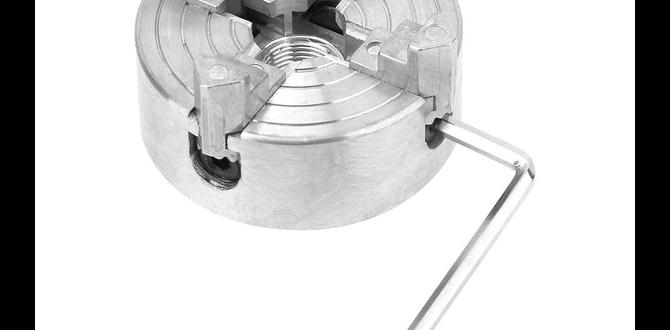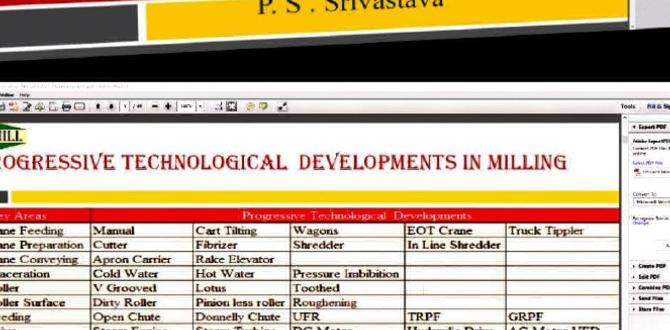Summary
Yes, a 3/16-inch carbide end mill is frequently proven effective for machining stainless steel, especially when chosen with the right specifications (like a specific flute count, coating, and helix angle) and used with appropriate cutting parameters. Look for tools designed for stainless steel and consider those with an 8mm shank if that’s your machine’s requirement, focusing on low runout for best results.
Hey there, fellow makers! Daniel Bates here from Lathe Hub. Ever stared at a piece of shiny stainless steel, ready to cut, only to wonder if your little 3/16-inch carbide end mill is up to the task? It’s a common question, and for good reason. Stainless steel can be a stubborn beast, tough and prone to work hardening. Picking the right tool and knowing how to use it makes all the difference between a smooth cut and a frustrating battle. Don’t worry, we’re going to demystify this! We’ll walk through exactly why that 3/16″ carbide end mill can be your secret weapon for tackling stainless steel, covering what to look for and how to get the best performance. Let’s get your machine humming!
Why Stainless Steel Seems So Tough (And How Carbide Helps)
Stainless steel earned its name for a reason – it resists corrosion and rust beautifully. But that same alloying, which often includes chromium and nickel, also makes it significantly harder and tougher than plain carbon steels or aluminum. This means it requires more cutting force, generates more heat, and can quickly dull standard tooling. The tendency of stainless steel to “work harden” is another challenge: as you cut into it, the material immediately around the cut becomes even harder, making subsequent cuts tougher. This is where carbide tooling shines brighter than High-Speed Steel (HSS). Carbide, made from extremely hard tungsten carbide particles bonded with cobalt, offers superior hardness and heat resistance. It can cut harder materials at faster speeds without losing its cutting edge as quickly as HSS.
A 3/16-inch (which is roughly 4.76mm) carbide end mill might seem small, but its solid carbide construction gives it exceptional rigidity and cutting ability for its size. This is crucial for detail work and for smaller milling machines where rigidity is at a premium. When we talk about machining stainless steel, especially without breaking the bank on massive tools, a well-chosen 3/16-inch carbide end mill is often more than capable, provided we understand its nuances.
Choosing the Right 3/16-Inch Carbide End Mill for Stainless Steel
Not all carbide end mills are created equal, and using the wrong one on stainless steel is a recipe for disaster. Here’s what separates a stainless-steel-slaying end mill from one that will just get gummed up:
Key Features to Look For:
- Number of Flutes: For stainless steel, a common recommendation is to use end mills with fewer flutes, typically 2 or 3. More flutes mean less chip clearance. Stainless steel produces stringy chips that can easily pack into the flutes, leading to tool breakage or poor surface finish. Fewer flutes provide better chip evacuation, which is critical.
- Coating: Coatings are like a protective shield for your end mill, enhancing performance and tool life. For stainless steel, coatings like TiCN (Titanium Carbonitride) or AlTiN (Aluminum Titanium Nitride) are excellent choices. These coatings add hardness, reduce friction, and improve heat resistance, all vital for cutting sticky materials like stainless steel.
- Helix Angle: The helix angle is the angle of the cutting edges. A higher helix angle (e.g., 45 degrees or more) is generally better for stainless steel. It allows for a smoother, more shearing cut, which reduces the force required and helps prevent work hardening. It also helps to lift chips away from the cutting zone more effectively.
- Material Grade of Carbide: The fineness of the carbide grain matters. A finer grain carbide offers higher toughness and wear resistance, which is beneficial for stainless steel.
- Short Projection / Rigidity: For smaller diameter tools like a 3/16″ end mill, tool deflection (also known as runout or wobble) can be a major issue. A shorter, more robust tool will deflect less. When searching for specific tools, you might see terms like “low runout” or descriptions indicating a strong, rigid shank, often a parallel shank.
- Shank Diameter (e.g., 8mm Shank): While we’re focusing on a 3/16-inch cutting diameter, the shank diameter is also important. In many metric-based machines or collet systems, an 8mm shank is common for tools around this size. Ensuring the shank fits your collet or tool holder securely is paramount for rigidity and accuracy. An 8mm shank provides a good balance of stiffness for a 3/16″ cutting diameter.
Material Suitability Table
Here’s a quick look at how different end mill features perform with stainless steel:
| Feature | Ideal for Stainless Steel | Why |
|---|---|---|
| Number of Flutes | 2 or 3 Flutes | Better chip clearance, prevents packing. |
| Coating | TiCN, AlTiN | Increased hardness, reduced friction, heat resistance. |
| Helix Angle | 45° or Higher | Shearing cut, reduced force, better chip evacuation. |
| Carbide Grade | Fine Grain | Higher toughness and wear resistance. |
| Tool Length | Standard or Short Projection | Minimizes deflection and vibration. |
Setting Up for Success: Machine and Workholding
A great end mill is only half the battle. How you set up your machine and hold your workpiece is just as critical for successfully milling stainless steel.
Machine Considerations:
- Rigidity is King: Stainless steel demands a rigid setup. Ensure your milling machine has minimal play in the ways, a tight spindle, and a robust tool holding system. Even a small amount of flex can lead to chatter, poor finish, and tool breakage. Hobbyist machines might require more careful setup and lighter cuts.
- Spindle Speed (RPM): Stainless steel requires slower spindle speeds compared to softer metals like aluminum. Too fast, and you’ll build up excessive heat, causing the tool to clog and dull.
- Feed Rate: This is the speed at which the tool advances into the material. For stainless steel, a slightly slower feed rate than you might use for aluminum is often better, especially when starting. This helps maintain a consistent chip load and prevents rubbing, which generates heat.
Workholding:
Your workpiece needs to be held absolutely rock solid. Any movement during the cut will lead to poor results and danger.
- Vise: A good quality milling vise, securely bolted to the machine table, is essential. Ensure the vise jaws are clean and provide a firm, even grip across a suitable length of your workpiece. Consider using soft jaws if you’re concerned about marring the surface, but ensure they still provide a very firm hold.
- Clamps: If you’re not using a vise, sturdy clamps can work, but they require careful placement to ensure the entire workpiece is supported and doesn’t lift or shift during milling.
- Fixturing: For more precise or repetitive work, custom fixtures can provide superior holding power and accuracy.
Always ensure your workpiece is positioned so that the majority of the milling operation occurs supported by the vise or fixture. Don’t let a long overhang hang off the edge of your vise jaws if you can avoid it.
Key Machining Parameters for 3/16″ Carbide on Stainless Steel
Getting the numbers right is where the magic happens. These are starting points, and you’ll likely need to adjust them based on your specific machine, the exact grade of stainless steel, and the end mill you’re using. Always start conservatively!
Suggested Cutting Speed and Feed Rate Ranges:
For a 3/16-inch (0.1875″) 2- or 3-flute carbide end mill, especially one with a coating for stainless steel, here are some general guidelines:
- Cutting Speed (Surface Feet per Minute – SFM): For stainless steel (like 304 or 316), you’re typically looking in the range of 40-70 SFM.
- Spindle Speed (RPM): To convert SFM to RPM, we use the formula: RPM = (SFM 3.82) / Diameter (inches).
- Using the lower end (40 SFM): RPM = (40
3.82) / 0.1875 ≈ 819 RPM
- Using the higher end (70 SFM): RPM = (70 3.82) / 0.1875 ≈ 1427 RPM
So, a good starting range for RPM would be 800 – 1400 RPM. Start lower if you’re unsure.
- Chip Load per Flute (Inches per Tooth – IPT): This is critical for preventing rubbing and overheating. For a 3/16″ end mill in stainless steel, a reasonable starting point is 0.001″ – 0.003″ IPT.
- Feed Rate (Inches per Minute – IPM): This is calculated by: IPM = RPM Number of Flutes IPT.
- Using the lower end (800 RPM, 2 flutes, 0.001″ IPT): IPM = 800 2 0.001 = 1.6 IPM
- Using a mid-range (1100 RPM, 2 flutes, 0.0015″ IPT): IPM = 1100 2 0.0015 = 3.3 IPM
- Using a mid-range (1100 RPM, 2 flutes, 0.002″ IPT): IPM = 1100 2 * 0.002 = 4.4 IPM
So, a starting feed rate might be between 2 – 5 IPM. Again, start conservatively.
Important Note on Chip Load: A chip load that is too small will cause the tool to rub instead of cut, generating heat and dulling the tool rapidly. A chip load that is too large can overload the tool, leading to breakage. Observing the chips is key: you want to see nice, curly chips, not fine dust (too small chip load) or chips that are too big and burly (too large chip load).
Depth of Cut and Stepover:
These parameters are highly dependent on your machine’s rigidity. For a 3/16″ end mill in stainless steel:
- Depth of Cut (DOC): When slotting (cutting a full-width slot), you’ll need a shallow DOC. Start with 0.020″ – 0.040″. When doing contouring (cutting around a shape), you can often take a deeper cut, perhaps 0.060″ – 0.125″, but always listen to your machine. If it chatters, reduce the DOC.
- Stepover: This is the amount the end mill moves sideways between each pass. For roughing, a stepover of 30-50% of the tool diameter (0.056″ – 0.094″) is common. For finishing passes, you’ll want a much smaller stepover, typically 5-15% (0.009″ – 0.028″), to achieve a good surface finish.
Cutting Strategies:
- Conventional Milling vs. Climb Milling: For stainless steel, especially with a smaller end mill, climb milling is often preferred. In climb milling, the cutter rotates in the same direction as the feed. This results in a “shearing” action, reducing cutting forces and workpiece deflection. However, it requires a machine with zero backlash in its feed mechanisms. Conventional milling (where the cutter rotates against the feed direction) can be more forgiving on machines with some backlash but tends to generate more heat and is more prone to chatter. Many CAM software packages default to climb milling for good reason.
- Peck Drilling for Slots: If you need to cut a deep slot, use a “peck” cycle. This involves drilling down a short distance (e.g., 0.060″), retracting to clear chips, then drilling down again. This dramatically improves chip evacuation and prevents tool breakage in deep cuts.
Machining Stainless Steel – A Step-by-Step Approach
Let’s put it all together into a practical sequence. Imagine you’re milling a simple pocket or outline in a piece of 304 stainless steel with your 3/16″ carbide end mill.
- Safety First: Always wear safety glasses. Ensure your machine guards are in place. Know where your emergency stop button is located.
- Secure the Workpiece: Mount your stainless steel stock firmly in a vise or fixture on the milling machine table. Ensure it’s clean and the vise jaws have a good grip.
- Install the End Mill: Insert your 3/16″ carbide end mill (with appropriate coatings and flute count for stainless steel) into a clean collet. Tighten the collet securely in the spindle. Ensure the shank size (e.g., 8mm) matches your collet. Minimize any overhang of the end mill to maintain rigidity.
- Set Work Zero: Use your machine’s probing method or edge finder to set your X, Y, and Z zero points accurately relative to your workpiece. For Z zero, it’s typically set at the top surface of the workpiece.
- Program or Manually Set Tool Path: This could be done via CAM software or by manually jogging the machine. For this guide, let’s assume manual operation for simplicity.
- Initiate Spindle and Coolant: Start the spindle at your calculated RPM (e.g., 1000 RPM). Turn on your cutting fluid or mist system. A good lubricoolant is vital for stainless steel to reduce friction, cool the cutting zone, and flush away chips. Water-based coolants are common, but specific solutions for stainless can also be beneficial.
- Engage the Cut:
- For a Pocket/Contour: Manually feed the end mill into the material at your programmed feed rate (e.g., 3 IPM). Engage the DOC (e.g., start with 0.040″).
- Listen and Observe: Pay close attention to the sound of the cut. Smooth cutting is good. High-pitched squeals or a rough, grinding sound indicates chatter, likely due to rigidity issues, too fast a speed, or too aggressive a depth/feed. Reduce DOC or feed rate if you hear chatter.
- Chip Evacuation: Watch the chips being produced. They should be well-formed and easily cleared by the coolant. If they start to look like fine powder or melt together, your chip load might be too small, or you’re overheating.
- Complete Passes: Continue milling along your programmed path. For pockets, you’ll typically do multiple passes, potentially increasing the DOC and stepover as you get closer to the final dimension, provided your machine is rigid enough. A final “finishing pass” with a shallow DOC and a tight stepover (e.g., 10%) will give the best surface finish.
- Retract and Stop: Once the operation is complete, retract the end mill clear of the part and stop the spindle.
- Inspect and Clean: Carefully inspect your workpiece for the desired dimensions and surface finish. Clean up any chips and coolant.
Troubleshooting Common Issues
Even with the best setup, you might run into a few snags. Here’s how to address them:
- Tool Breakage: Often caused by excessive force (too high feed rate or DOC), poor chip evacuation leading to re-cutting, lack of rigidity, or a sudden stall.
- Solution: Verify machining parameters, ensure good chip flow, check machine rigidity, and use peck drilling for slots.
- Excessive Heat / Gummy Chips: This is a hallmark of rubbing, not cutting.
- Solution: Increase spindle speed or feed rate to achieve a proper chip load. Ensure adequate lubrication/cooling. Check if your end mill is worn or damaged.
- Poor Surface Finish / Chatter: Usually indicates a lack of rigidity in the machine, workpiece, or tool. Can also be due to worn tooling.
- Solution:






